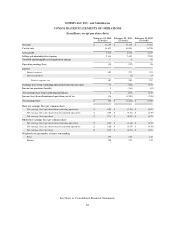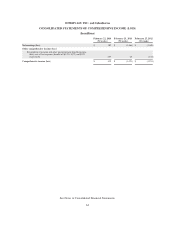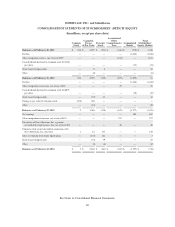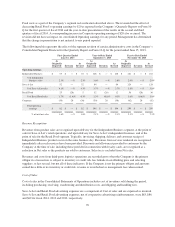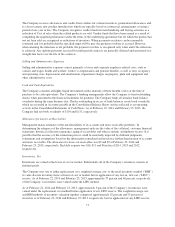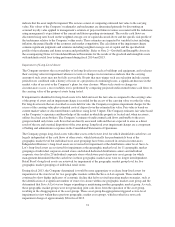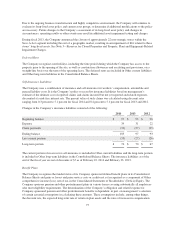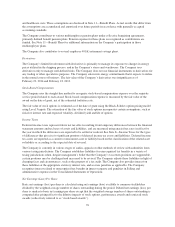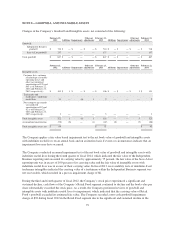Albertsons 2014 Annual Report Download - page 75
Download and view the complete annual report
Please find page 75 of the 2014 Albertsons annual report below. You can navigate through the pages in the report by either clicking on the pages listed below, or by using the keyword search tool below to find specific information within the annual report.Planned business dispositions are presented as discontinued operations when all the criteria described above are
met. Operations of the business components meeting the discontinued operations requirements are presented
within Income (loss) from discontinued operations, net of tax in the Consolidated Statements of Operations, and
assets and liabilities of the business component planned to be disposed of are presented as separate lines within
the Consolidated Balance Sheets. The estimated loss on the sale of NAI was recorded within Current liabilities of
discontinued operations as of February 23, 2013. See Note 14—Discontinued Operations and Divestitures.
Businesses held for sale are reviewed for recoverability of the carrying value of the business upon meeting the
classification requirements. Evaluating the recoverability of the assets of a business classified as held for sale
follows a defined order in which property and intangible assets subject to amortization are considered only after
the recoverability of goodwill, indefinite lived intangible assets and other assets are assessed. After the valuation
process is completed, the held for sale business is reported at the lower of its carrying value or fair value less cost
to sell, and no additional depreciation or amortization expense is recognized. The carrying value of a held for sale
business includes the portion of the accumulated other comprehensive loss associated with pension and
postretirement benefit obligations of the operations of the business.
There are inherent judgments and estimates used in determining impairment charges. The sale of a business can
result in the recognition of a gain or loss that differs from that anticipated prior to closing.
Property, Plant and Equipment, Net
Property, plant and equipment are carried at cost. Depreciation is based on the estimated useful lives of the assets
using the straight-line method. Estimated useful lives generally are 10 to 40 years for buildings and major
improvements, three to 10 years for equipment, and the shorter of the term of the lease or expected life for
leasehold improvements and capitalized lease assets. Interest on property under construction of $1, $4 and $6
was capitalized in fiscal 2014, 2013 and 2012, respectively.
Goodwill and Intangible Assets
Goodwill
The Company reviews goodwill for impairment during the fourth quarter of each year, and also if events occur or
circumstances change that would more-likely-than-not reduce the fair value of a reporting unit below its carrying
amount. The reviews consist of comparing estimated fair value to the carrying value at the reporting unit level.
The Company’s reporting units are the operating segments of the business which consist of Independent
Business, Save-A-Lot and Retail Food. As of February 22, 2014, Goodwill balances existed in the Save-A-Lot
and Independent Business reporting units. Fair values are determined by using both the market approach,
applying a multiple of earnings based on the guideline publicly traded company method, and the income
approach, discounting projected future cash flows based on management’s expectations of the current and future
operating environment. The rates used to discount projected future cash flows reflect a weighted average cost of
capital based on the Company’s industry, capital structure and risk premiums in each reporting unit including
those reflected in the current market capitalization. If management identifies the potential for impairment of
goodwill, the fair value of the implied goodwill is calculated as the difference between the fair value of the
reporting unit and the fair value of the underlying assets and liabilities, excluding goodwill. An impairment
charge is recorded for any excess of the carrying value over the implied fair value.
The Company reviews the composition of its reporting units on an annual basis and on an interim basis if events
or circumstances indicate that the composition of the Company’s reporting units may have changed. There were
no changes in the Company’s reporting units as a result of the fiscal 2014 and 2013 reviews.
Intangible Assets
The Company also reviews intangible assets with indefinite useful lives, which primarily consist of trademarks and
tradenames, for impairment during the fourth quarter of each year, and also if events or changes in circumstances
73


